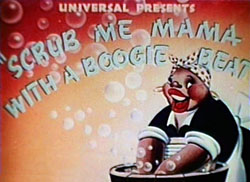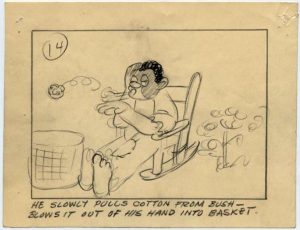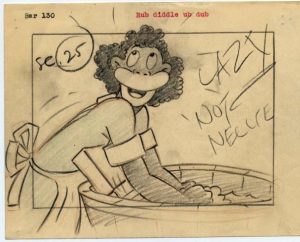
This year marks the seventieth anniversary of a significant milestone in ethnic imaging in animation. In 1949 Universal Pictures withdrew its reissue of Walter Lantz’s cartoon Scrub Me Mama with a Boogie Beat from distribution. It was no small accomplishment. The film had been in theaters for months, and Universal stood to lose money from pulling the film. However, civil rights groups had complained of the African American stereotypes in the cartoon, and their pressure on Universal ultimately led to the withdrawal of the film.
 At the time Universal did not have an active animation studio and could only redistribute its old cartoons. Lantz had severed his ties to the company, and in 1947 he began a brief arrangement of cartoon production for United Artists. Universal chose to reissue cartoons whose original releases had won over audiences, and Scrub Me Mama was one of those films when it first arrived in theaters in 1941. The film depicts southern African Americans in fictional Lazytown. While women work as laundresses, men either sleep or perform actions with exaggerated lethargy. They become energized when a light-skinned woman from Harlem drops by from a riverboat and shows the laundresses how to scrub with rhythm–thus, the title of the film.
At the time Universal did not have an active animation studio and could only redistribute its old cartoons. Lantz had severed his ties to the company, and in 1947 he began a brief arrangement of cartoon production for United Artists. Universal chose to reissue cartoons whose original releases had won over audiences, and Scrub Me Mama was one of those films when it first arrived in theaters in 1941. The film depicts southern African Americans in fictional Lazytown. While women work as laundresses, men either sleep or perform actions with exaggerated lethargy. They become energized when a light-skinned woman from Harlem drops by from a riverboat and shows the laundresses how to scrub with rhythm–thus, the title of the film.
Back in 1941 activists had not organized campaigns to get cartoons pulled from theaters, and they made no effort to target Scrub Me Mama then. By the fall of 1948, however, World War II came and went, and in that time civil rights groups began decrying films that grossly stereotyped African Americans as giving propaganda to the enemy. After the war, organizations like the National Association for the Advancement of Colored People (NAACP) argued that such films were harmful for children; the NAACP’s later work in the Brown v. Board case showed how stereotypes became ingrained in children at very young ages. Meanwhile, animation producers met with some activists as early as 1944 and agreed to tone down the content. So, in 1948, a reissue of a broad-humored cartoon from before the war stuck out among civil rights groups like a sore thumb.
 The NAACP wrote to Universal to request the film’s withdrawal, but the distributor refused. A public relations official offered several reasons for keeping the film in theaters. The cartoon was too popular and had never generated complaints before, it was typical of ethnic imaging from Hollywood, and it could result in other films and film projects disappearing and therefore give African American actors less work. The last reason was a sore spot for groups like the NAACP, because some African American actors publicly complained about the organization’s campaigns against radio and television shows that employed them to play the comical roles.
The NAACP wrote to Universal to request the film’s withdrawal, but the distributor refused. A public relations official offered several reasons for keeping the film in theaters. The cartoon was too popular and had never generated complaints before, it was typical of ethnic imaging from Hollywood, and it could result in other films and film projects disappearing and therefore give African American actors less work. The last reason was a sore spot for groups like the NAACP, because some African American actors publicly complained about the organization’s campaigns against radio and television shows that employed them to play the comical roles.
After months of fruitlessness, the NAACP asked fellow civil rights group the Jewish Labor Committee to communicate with Universal about the cartoon. The organization did, and only then–in February 1949–did Universal pull Scrub Me Mama With A Boogie Beat. Other campaigns against cartoons followed, and some were more successful than others. My book, The Colored Cartoon, chronicles those efforts in detail.








 Christopher P. Lehman is a professor of ethnic studies at St. Cloud State University in St. Cloud, Minnesota. His books include American Animated Cartoons of the Vietnam Era and The Colored Cartoon, and he has been a visiting fellow at Harvard University.
Christopher P. Lehman is a professor of ethnic studies at St. Cloud State University in St. Cloud, Minnesota. His books include American Animated Cartoons of the Vietnam Era and The Colored Cartoon, and he has been a visiting fellow at Harvard University.



























Umm…..could you find a copy with ti’s original unaltered mono soundtrack? It doesn’t have to be IB Tech it just has to be one with out all those annoying stock sound effects added in not part of or borrowed to the Lantz film library. It disservices’ to the films historical aspect since it the original soundtrack, poor or not, is hard to find.
I know some people want Dolby or DTS “Surround Sound” on public domain DVDs, that’s fine. But us buffs want mono.
Thank you for your time.
ParamountCartoons
here:
https://www.youtube.com/watch?v=aK826hOZFvg
has original mono soundtrack
Thanks!
Musically, this is a very entertaining cartoon. I became aware of this years beyond my childhood. Knowing what I know now, I didn’t even have to physically see it to realize why it is offensive to African-Americans, but it is also interesting that the studio pushed for its continued public viewings, so other such projects would keep African-American actors and performers working, even if it wasn’t in some lavish, big budgeted live action vehicle where said actor or performer could be viewed for his or her acting chops. The production number here is of its time and I wonder what would have been thought of it without the cartoon.
Maybe those racist, etc. cartoons could be put in a graveyard shift programming block like Adult Swim that has a REPUTATION for low moral quality.
“Scrub Me Mama” was also released in 8mm and 16mm to the home movie market via Castle Films in the late 1940s. It was still in their 1950 catalog.
Although this cartoon is obviously stereotypical, the music track was an example of why black performers were still nervous about losing work in that era. I wrote to Leroy Hurte in 1999. He had the vocal group The Four Blackbirds in the early 1930s (in which he sang) and they supplied excellent vocalizing in several cartoons, like MGM’s THE OLD MILL POND. By the time SCRUB ME was in production Hurte was arranging music for films, as well as managing singers and vocal groups for work in the Central Avenue nightclub area of L.A.. Hurte was asked to help on this cartoon by Lantz’s musical director Darrell Calker and he contracted the famous African American singer Nellie Lutcher to supply the vocal for the girl in the cartoon. It’s a pity that Mel Blanc’s frankly awful black dialect was used throughout as the character voices for all the lazy male folk…his stock “negro” accent was always his worst cartoon voice by far. Hurte discusses this cartoon in a comprehensive book called Central Avenue: Its Rise and Fall by Nancy Cox (and another book which references theatrical cartoon work is The Black Music History of Los Angeles by Tom Reed).
That Tom Reed work is a mighty pricey work to add to one’s collection! Thanks very much for the terrific info, though!
Are you on a computer? Cell? Tablet? Then trust me you can afford it. IF the information has any value to you. Deff worth it.
Fascinating article, especially the studio defending the re-release. Can’t imagine cartoons being THAT profitable — was there a broader policy of rejecting public appeals?
A similar cartoon, “Boogie Woogie Bugle Boy of Company B”, did make it onto a Woody Woodpecker DVD set. Arguably a little milder than “Scrub Me Mama”, but still in the same territory (the women in translucent skirts are recycled here). Was it re-released, or did the WWII theme date it too much? Did it draw any attention?
Whenever I think the film’s main “stereotype” of it’s “standards” beauty and singing, I laugh because I am always reminded of this woman’s tragic tale:
https://en.wikipedia.org/wiki/Florence_Ballard
I seem to recall reading that when revisiting the film later on, Lantz himself was shocked and horrified about the whole thing and decided to disown the film which might be why this eventually fell into the Public Domain.
Keith Scott– agreed about Blanc’s Afro-American voice. It’s painful to hear.
I wonder if the NAACP protested Tex Avery’s HALF-PINT PYGMY when it hit theaters in 1948? It was obviously not reissued, and I don’t think TV stations ever showed it. It’s shocking to see such a hideous stereotype so late in American popular culture–and Avery did subsequent “blackface” explosion gags in a couple of later cartoons. It’s disturbing and fascinating how hard it was for this to be ejected from mass media.
Half-Pint Pygmy was indeed shown on TV, deep into the ’80s. It was still part of the MGM/UA 16mm rental catalog, under “The Hobo Bears”.
The only new cartoons that were targeted by protesters were Warner Bros.’ “Coal Black” and “Angel Puss,” George Pal’s Jasper series, and Famous Studios’ “Song of the Birds.” Otherwise, activists campaigned against reissued cartoons. African stereotypes were not targeted at the time–just the southern African American figures.
The opening…. title card, was that done with airbrushing? It looks like it. As for the cartoon, I saw it on YouTube, once. And I’ll leave it at that.
Dear Friends, What band played the soundtrack for this short?